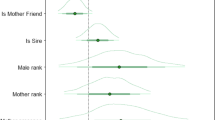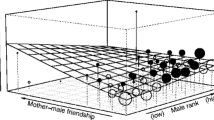Abstract
Theory suggests that it is in the interest of an infant to garner more care than its mother is selected to provide and that a rival sibling would curtail care from the mother. Thus delayed conception in the mother would be of advantage to the infant. One method of achieving this result would be to interfere with the mother's potential matings. To test this theory, the conflict between mothers and their infants in relation to maximizing inclusive fitness has been studied inMacaca fascicularis and infant interference has been observed. Focal animal samples were taken on 8 mothers and their 13 infants. Interactions analyzed were those between the mother and (1) an adult male, (2) her infant, (3) an adult female, (4) her infant and an adult male, (5) her infant and an adult female. Only explicit behaviours were analyzed. The infant's interference was found to be significantly related to its mother's mating, and this produced a deterring effect on the male. Infants did not interfere with any female's matings other than those of their mother. The interference was related to the number of mother-male contacts. In mothers that did subsequently conceive, infant interference at mating increased up to the mother's conception date and decreased thereafter. By contrast to the infants direct method, mothers approached the conflict indirectly. There were significantly more contacts and mounts with males in their infant's absence, they reacted negatively to their infant only when it had interfered, they were more lenient in the presence of an adult female than with an adult male, and they avoided their infant's presence at mother-male contacts. No significant sex bias in interference or the number of contacts with mother-male pairs has been found. There are indications of a sibship pattern of interference.
Similar content being viewed by others
References
Altmann, J., 1974. Observational study of behavior, sampling methods.Behaviour, 49: 227–267.
————, 1980.Baboon Mothers and Infants. Harvard Univ. Press, Cambridge, Massachusetts.
Angst, W., 1975. Basic data and concepts on the social organization ofMacaca fascicularis.Prim. Behav., 4: 325–388.
Community Transitional Resources, 1983. Harassment of matings in the stumptailed macaque (Macaca arctoides).Amer. J. Primatol., 4(4): 351. (Abstract)
De Benedictis, T., 1973. The behavior of young primates during adult copulations: Observations of aMacaca irus colony.Amer. Anthropol., 75(5): 1469–1484.
Delvoye, P., M. Badawi, M. Demaegd, & C. Robyn, 1978. Long lasting lactation is associated with hyperprolactinemia and amenorrhea. In:Progress in Prolactin Physiology and Pathology,C. Robyn & M. Harter (eds.), Elsevier/North Holland Biomedical Press, pp. 212–232.
Fujiwara, T. &T. Imamichi, 1966. Breeding of cynomolgous monkeys as an experimental animal.Jap. J. Med. Sci. Bio., 19: 225–226.
Gouzoules, H., 1974. Harassment of sexual behavior in the stumptail macaque,Macaca arctoides.Folia Primatol., 22: 208–217.
Hamilton, W. D., 1964. The genetical evolution of social behavior.J. Theoret. Biol., 7: 1–52.
Jewett, D. A. &W. R. Dukelow, 1972. Cyclicity and gestation length ofMacaca fascicularis.Primates, 13: 327–330.
Loy, J. &K. Loy, 1977. Sexual harassment among captive patas monkeys (Erythrocebus patas).Primates, 18: 691–699.
MacDonald, G. J., 1971. Reproductive patterns of three species of macaques.Fertil. Steril., 22: 373–377.
Niemeyer, C. L. &J. R. Anderson, 1983. Primate harassment of matings.Ethol. Sociobiol., 4: 205–220.
———— &A. S. Chamove, 1983. Motivation of harassment of matings in stumptailed macaques.Behaviour, 87: 298–323.
Siegel, S., 1956.Nonparametric Statistics. McGraw-Hill Book Co., New York.
Trivers, R. L., 1974. Parent-offspring conflict.Amer. Zool., 14: 249–264.
Tutin, C. E. G., 1979. Responses of chimpanzees to copulation, with special reference to interference by immature individuals.Anim. Behav., 845–854.
Zucker, E. L. &J. R. Kaplan, 1981. A reinterpretation of “sexual harassment” in patas monkeys.Anim. Behav., 29(3): 957–958.
Author information
Authors and Affiliations
About this article
Cite this article
Gore, M.A. Mother-offspring conflict and interference at mother's mating inMacaca fascicularis . Primates 27, 205–214 (1986). https://doi.org/10.1007/BF02382599
Received:
Accepted:
Issue Date:
DOI: https://doi.org/10.1007/BF02382599




